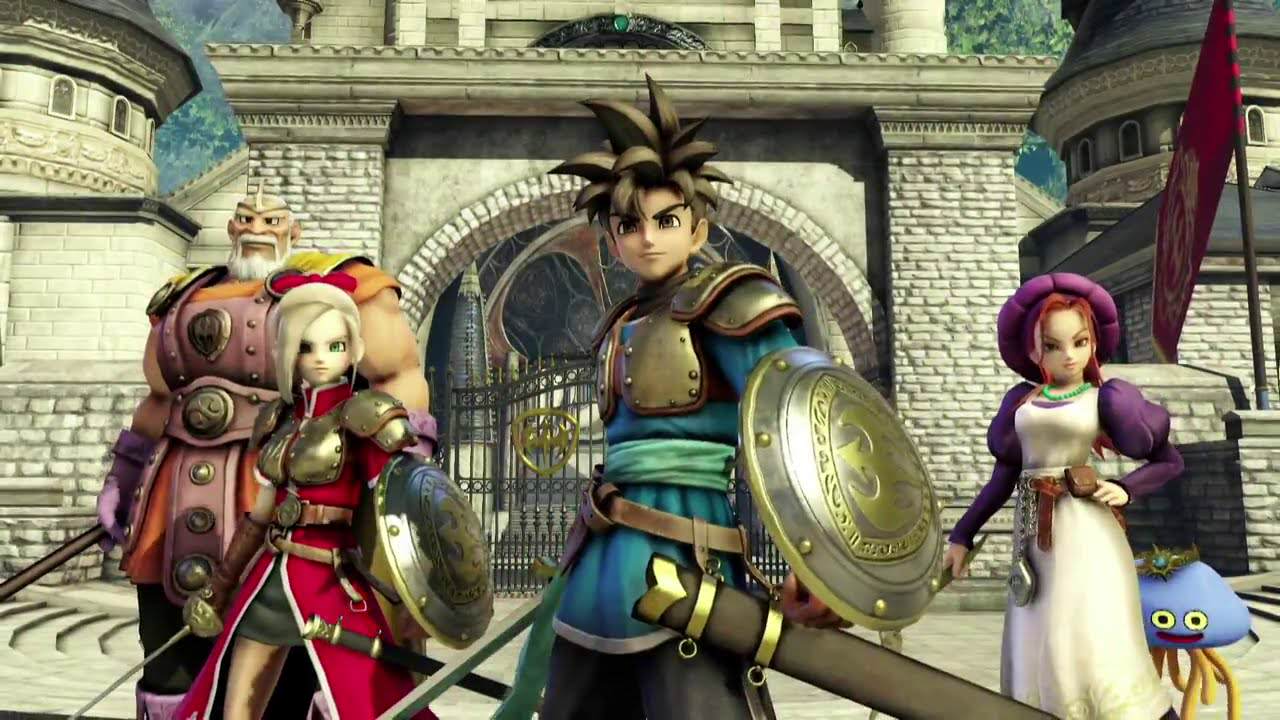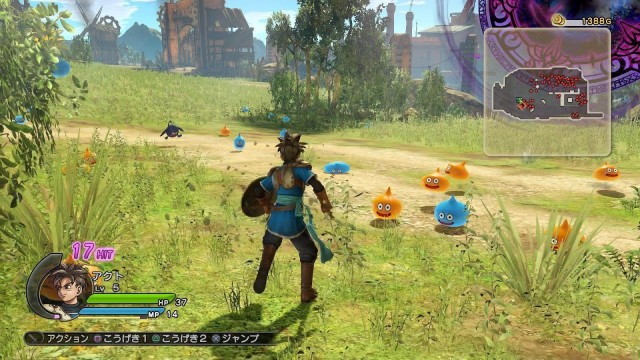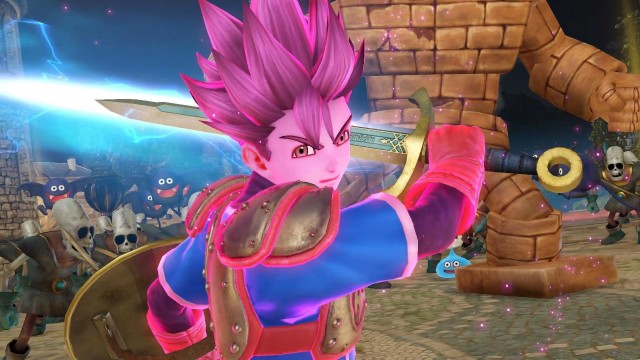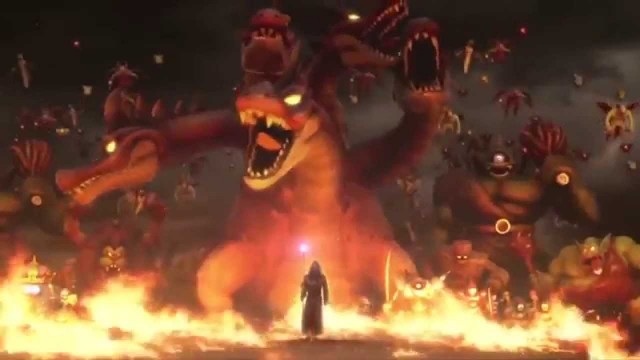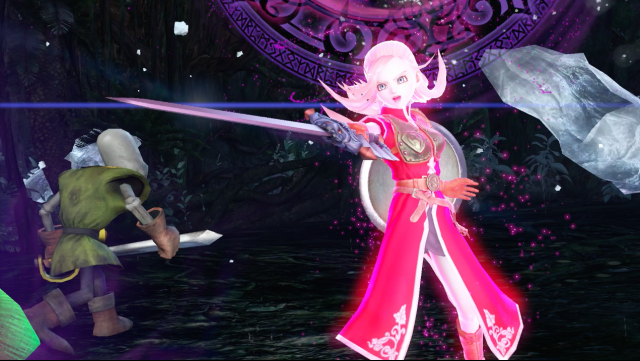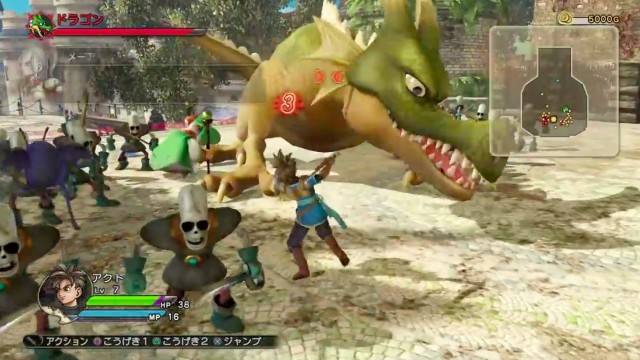Last year, Tecmo Koei subsidiary developer, Omega Force made a big splash with their hit Wii U exclusive, Hyrule Warriors, which brought their tried-and-true hack-and-slash Warriors gameplay to the world and characters of Nintendo’s Legend of Zelda franchise, and opened the floodgates for a whole bunch of Warriors conversions for other beloved Japanese game franchises. On the back of that game’s success, Omega Force is naturally attempting another big play at a highly beloved Japanese game series, this time Square Enix’s beloved RPG franchise, Dragon Quest!
While more of a cult hit series in the West, Dragon Quest is nothing short of a massive cultural phenomenon in its native Japan, and this is largely due to its endearing heroes and charming monsters. Given all of the appeal that oozes from the cast of this series’ long-running mainline installments, it was ripe for the Warriors treatment, and thus, we have Dragon Quest Heroes: The World Tree’s Woe and the Blight Below (boy, that’s a mouthful!), a Warriors-inspired spin-off that takes the recognizable cast and world of Dragon Quest, and brings it into the hack-and-slash genre. I’m not sure why the game wasn’t called ‘Dragon Quest Warriors‘ in this case, especially since the ‘Dragon Quest Heroes‘ moniker has already been used by the completely underrated (and adorable!) 2006 Nintendo DS game, Dragon Quest Heroes: Rocket Slime, which is wholly unrelated to this new offering in style and tone, but that’s ultimately a minor quirk.
Being a big Dragon Quest fan myself, I was thrilled to get some early hands-on time with a pre-release demo for Dragon Quest Heroes (I’m going to omit the lengthy subtitle to preserve my precious typing fingers!), which is releasing exclusively on the PlayStation 4 here in the West. A PlayStation 3 port exists in the game’s native Japan, but Square Enix isn’t bothering with localizing it. Given the fact that the PlayStation 4 is arguably the most beloved console in Western territories right now, it’s hardly surprising that the last-gen port is staying in Japan, where the PlayStation 4 is a much slower seller, with the PlayStation 3 still being the country’s preferred Sony console by and large. I doubt that Dragon Quest fans in the West will care about only having one option though, especially since the game has some cool little bells and whistles that are unique to the PlayStation 4 build anyhow, on top of the current-gen version’s expected superior graphical resolution and performance, in contrast to its last-gen sibling in the Land of the Rising Sun.
Anyway, the demo gave me a chance to play test two areas, the first being a big field of monsters, and the second being a boss fight of sorts against a Gigantes, which is one of many recognizable Dragon Quest foes that you can engage in Dragon Quest Heroes. Being the bold hero that I am, I decided to take on the Gigantes first. Since I’m not a Warriors veteran however, I opted for the Simple Control option to get my feet wet, leaving the Smooth Control option for my second go.
Upon starting the session, I immediately found myself and my party up against the Gigantes, who had a few minions at his side, including Slimes, Slime Knights and a few Liquid Slimes. Taking control of the game’s original hero, Luceus, a brave knight with an Akira Toriyama-approved spiky hardo, I was unleashed upon the action. At my side, were Luceus’ sister, Aurora, who appeared to be a magic user, and two familiar personalities from Dragon Quest VIII: Journey of the Cursed King, those being axe-wielding bruiser, Yangus, and busty spellcaster, Jessica. I was tickled at the sight of fighting alongside them again, given that Dragon Quest VIII: Journey of the Cursed King is a particularly good installment in this franchise, and one of my personal favourites. Their familiar accents were still with them, as were their plucky personalities, as they spoke over the battle, helping the combat feel alive and dynamic, and helping me to adjust to the fact that I was no longer playing a turn-based Dragon Quest game.
In fact, on the note of the voices, there’s a neat touch in the game’s PlayStation 4 build, where your supporting characters’ voices will actually speak out of the controller’s mic, rather than out of the television. Obviously, the Japanese PlayStation 3 build doesn’t offer this little perk, and, while I could barely make out the voice acting coming from the Dual Shock 4 mic when I was in a crowded public place, it was very cool nonetheless.
As for the gameplay, Warriors fans can quickly jump right in, and even if you’ve barely touched the Warriors series, like myself, Dragon Quest Heroes is easy to grasp the fundamentals of. As with most of Omega Force’s Warriors games, you press buttons to slash your way through legions of foes, which, in this case, were obviously recognizable Dragon Quest monsters. Little damage counters fly out of any enemies that you connect hits with as well, which is a neat little touch that helps to root the game more in its RPG inspirations. Combat is obviously now in real-time, unlike the retro chic turn-based RPG combat of the mainline Dragon Quest games, but even if you’re coming into Dragon Quest Heroes as a Dragon Quest fan, rather than a Warriors fan, the game is appealing and fun to play.
The simple control scheme allowed me to easily chain together presses of Square and Triangle to attack foes, with Square being for quick, light attacks and Triangle being for slower, heavier attacks, leaving defending with Circle, and jumping with X. You can also switch control between characters by pressing R2, which is handy, since the A.I. is a little unreliable (especially with fallen characters, which you must run to and revive with a limited supply of healing herbs when they fall in battle), and you can hold R1 to use special attacks with the Square, Triangle, Circle or X Buttons, which help with crowd control, though obviously, they have limited uses and charge times, so you can’t spam them willy-nilly. As you defeat enemies, you can build up a Super Meter to trigger very powerful special attacks as well. The combat is simple, but there’s enough strategy to it to help you feel that you are powerful, without feeling over-powered, which Omega Force keeps in check very well with these types of games.
Of course, none of this helped me against the Gigantes, whom you can barely scratch, despite me wailing on him for almost five minutes straight. Yangus soon calls out that the current strategy won’t work, and we need to try something else. Unfortunately, it took me a while to figure out that you actually need to stagger the Gigantes by hitting its legs, while avoiding its own very damaging attacks, of course (which your allies often fail to do, sadly), and then attack its eye. My party was heavily decimated, but even when I got my strategy straight, I sadly wasted too much time chasing the Gigantes around the village, futily trying to damage it. My demo timed out, and I had to switch to the other play mode.
Still, I chalk that up to my own brain fart, not to the game. Dragon Quest fans may have a bit of trouble getting used to the surprisingly strategic action-based combat, but it certainly can be done. The game and your allies do a decent job of helping you get a handle on things, and after a bit of practice, attacking enemies quickly becomes instinct, even if you’ve never touched a Warriors game before. It also helps that Dragon Quest Heroes doesn’t feel like a cut-and-shut Warriors clone, since things like your party of characters and the item use help to give it its own unique flavour, with the hack-and-slash combat naturally making it stand apart from most any other Dragon Quest offering before it.
Helping further is the fact that Dragon Quest Heroes is very faithful to the style of Dragon Quest, even with the drastic gameplay alterations. The presentation and visual style will be very recognizable and comfortable for Dragon Quest fans, and will look especially cool to newcomers, since the character models especially look quite sharp on the PlayStation 4 hardware! Environments are a little uneven, and some monsters definitely look better than others, but this is no half-assed spin-off! Dragon Quest Heroes is quite polished, with sharp, vibrant graphics and a smooth framerate in its PlayStation 4 build, complete with menus, character designs and a soundtrack that are also equally appealing to listen to for enthusiasts of Japanese gaming. The presentation won’t blow you away when you compare it to something like Bloodborne (though I do concede that the presentation stylings of Bloodborne and Dragon Quest Heroes are apples and oranges), but it still helps Dragon Quest Heroes feel like the coolest and most stylish Dragon Quest game made to date, though not at the expense of the series’ infectious charm.
As for the ‘Field of Fiends’, this felt a little more like recognizable Warriors gameplay than the Gigantes fight, which more showed off the game’s Dragon Quest side of inspiration, with consumable items, spell use and party management still demonstrably being a part of gameplay. Now however, I was doing the usual Warriors song and dance that even I recognize, namely moving around a large open field, and taking out collections of enemies, which now include a few more Dragon Quest monster variations like Drackeys and Dreadknights. Aurora was once again at my side, but this time, it was two personalities from Dragon Quest IV: Chapters of the Chosen that joined me, namely sorceress princess, Alena, and healing priest, Kiryl.
I took this opportunity to swap controls between characters more often, this time using the more advanced control scheme, but I didn’t feel that it made too much of a difference, especially now that mashing Square to get through every battle was more feasible. I also noticed that, while there are subtle differences between characters’ aptitudes, and obviously their special abilities, all of them are able to slice through hordes of enemies in true Warriors style, so while characters like Kiryl obviously can’t stand with the battle-readiness of someone like Luceus, at least Kiryl doesn’t feel like he can’t defend himself either.
Obviously, this was not one of the game’s more challenging areas, so I imagine that the final game will be more along the lines of the engaging challenge behind the Gigantes fight, though I did appreciate the chance to play a more straightforward combat scenario, and sheepishly wish I’d swallowed my pride and started with that one. Even as I obliterated every enemy, and found myself up against a small platoon of Skeletons surrounding a boss Golem soon afterward, I enjoyed myself, and enjoyed the sense of charm and empowerment that Dragon Quest Heroes employs in equal measure. After the Golem was vanquished however, and I ran around to collect some money and crafting items that were dropped by fallen foes, my time with the demo was sadly done.
Dragon Quest Heroes seems to be a surprisingly well-made spin-off, with more production values than you would think. Despite it taking the largely retro, turn-based sensibilities of Dragon Quest, and putting it into the foreign realm of hack-and-slash excitement, the mash-up works as well as it did in Hyrule Warriors on the Wii U (so, pretty well!), and I believe that both Dragon Quest fans and Warriors fans should have this game high on their radar. It’s very charming, and despite being fundamentally straightforward, there’s more depth and engagement to the combat than you may realize. Given the sadly sparse state of PlayStation 4 exclusives in 2015 especially, Dragon Quest Heroes could end up being an under-the-radar hit for Sony’s console this Holiday season, and a great way to possibly convert even more players to the eventual release of Dragon Quest XI when that hits the West. After all, those adorable Slimes are difficult to say no to!
Look for Dragon Quest Heroes: The World Tree’s Woe and the Blight Below on October 13th in North America, and October 16th in Europe, exclusively for PlayStation 4.

